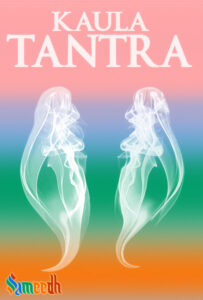Kaula Tantras refer to a set of esoteric texts and practices that originated within the broader umbrella of Tantra, a spiritual tradition in Hinduism and Buddhism. The term “Kaula” is derived from the Sanskrit word “Kula,” which means “family” or “clan.” Kaula Tantras are characterized by their emphasis on the worship of the divine in its female aspect, known as Shakti, and the incorporation of ritual practices involving sexual energy.

In Hinduism, Kaula Tantras emerged as a part of the broader Tantric tradition, which seeks spiritual enlightenment through the direct experience of the divine. Kaula Tantras emphasize the idea of the body as a microcosm of the universe and advocate for the integration of all aspects of human experience, including the physical and the spiritual.
These texts are often associated with the worship of Shiv and Shakti in their intimate union, symbolizing the union of male and female energies, as well as the macrocosm and microcosm. Kaula Tantras are known for their focus on the body as a microcosm of the universe and for their use of various ritual techniques, including mantra, yantra (sacred diagrams), and mudra (gestures).
The practices within Kaula Tantras can vary widely, ranging from relatively mild forms of meditation and mantra repetition to more intense rituals involving sexual practices (known as maithun) as a means of spiritual transcendence. It’s important to note that these practices are often highly symbolic, and the sexual aspects are understood metaphorically rather than literally in many interpretations.
Kaula Tantras traditionally emphasize the importance of the guru-disciple relationship. The guru serves as a spiritual guide who initiates the disciple into the teachings and practices of the tradition, leading them on the path to spiritual realization.
It’s important to note that interpretations and practices within Kaula Tantras can vary widely, and not all practitioners engage in or advocate for the more controversial aspects such as maithuna. Additionally, the symbolic nature of many of these practices is often emphasized, with the sexual elements understood metaphorically rather than literally.
While Kaula Tantras have been historically influential within certain Tantric lineages, they have also faced criticism and misunderstanding, leading to their marginalization in some religious circles. Nonetheless, they remain an important aspect of Hindu Tantra, offering a unique perspective on spiritual practice and the worship of the divine.
Kaula Tantras have had a significant influence on various schools of Tantra, particularly within the Shakta tradition, which focuses on the worship of the divine feminine. However, due to their esoteric nature and emphasis on practices that are often misunderstood or controversial, Kaula Tantras have sometimes been marginalized or misrepresented in mainstream religious discourse. Nonetheless, they remain an important aspect of the broader Tantric tradition and continue to be studied and practiced by some today.